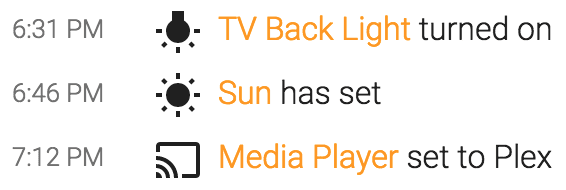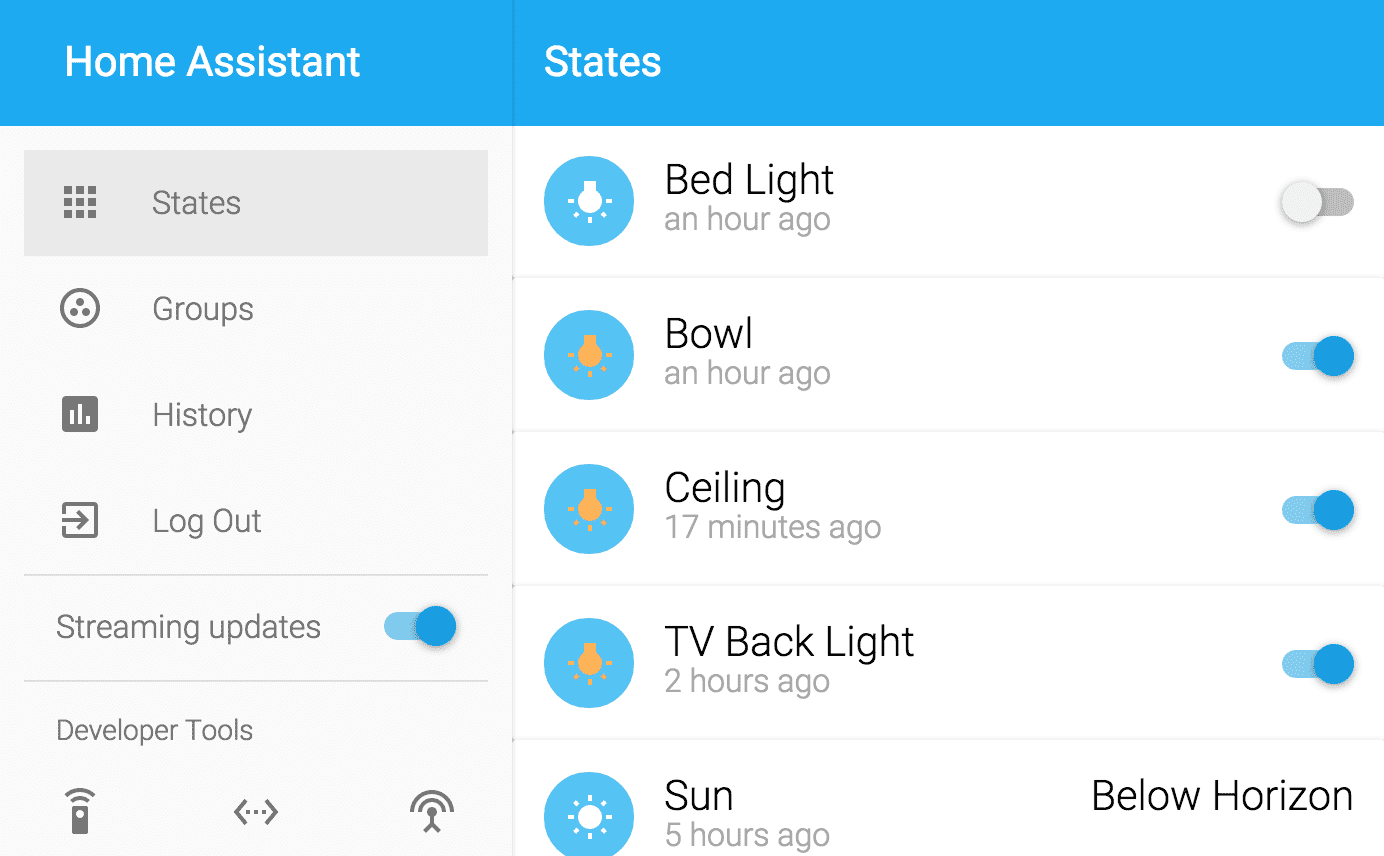Blog
Release notes for May 14, 2015
Almost three busy weeks have past since the last release. We used this time to finally make the overhaul to use UTC as the internal date time format. We added a bunch of test coverage in the process to make sure the transition went smoothly. Pleas see the blog post about the UTC refactor for backwards incompatible changes.
This release includes a significant startup boost for the frontend and a fix for Wemo discovery after their latest firmware upgrade.
I would like to give a big shout out to our newest contributor fabaff
UTC & Time zone awareness
I have recently merged code to refactor Home Assistant to use only UTC times internally. A much needed refactor. I’ve added some extra test coverage to time sensitive parts to ensure stability. The code has been live in the dev branch for the last 9 days and will be soon released to the master branch.
From now on all internal communication will be done in UTC: time changed events, datetime attributes of states, etc. To get the current time in UTC you can call homeassistant.util.dt.utcnow(). This is a timezone aware UTC datetime object. homeassistant.util.dt
There is also such a thing as local time. Local time is based on the time zone that you have setup in your configuration.yaml. Local times should only be used for user facing information: logs, frontend and automation settings in configuration.yaml.
Setting up your time zone
Setting up a time zone happens in configuration.yaml. If you have no time zone setup, it will be auto detected using the existing detection code using freegeoip.net
homeassistant:
time_zone: America/Los_Angeles
Compatibility
The changes to the code are mostly backwards compatible. The old hass.track_time_change and hass.track_point_in_time use now internally two new methods: hass.track_utc_time_change and hass.track_point_in_utc_time. The usage of the old methods have not changed and should be backwards compatible.
This refactor adds a new migration for the database adding a utc_offset column to events and states. This information is currently not used but can prove useful in the future when we start analyzing the historical data.
Backwards incompatible stuff
All built-in components have been upgraded. The following list is only for people that run custom components:
-
hass.track_time_changeandhass.track_point_in_timewill now return a time zone aware datetime object. Python does not allow comparing a naive with an aware datetime object. - the sun attributes for rising and setting are now in UTC. The methods
sun.next_rising(hass)andsun.next_setting(hass)are backwards compatible, just be careful if you used to read the raw attributes. - the API sends all times in UTC. If you use anything else besides the frontend to talk to HA, make sure it handles it differently.
Release notes for April 25, 2015
It’s been a month since the latest update and a lot has happened again. Here a quick overview of the new things.
Line Charts
James

ISY994 hub support
 Ryan
Ryan
He has created an extensive getting started guide which can be found on the ISY994 component page.
# Example configuration.yaml entry
isy994:
Logbook
 I (Paulus) have added a logbook component. The logbook component provides a different perspective on the history of your house by showing all the changes that happened to your house in chronological order. See the demo for a live example.
I (Paulus) have added a logbook component. The logbook component provides a different perspective on the history of your house by showing all the changes that happened to your house in chronological order. See the demo for a live example.
# Example configuration.yaml entry
logbook:
Release notes for March 22, 2015
A new version of Home Assistant has just been pushed out. It contains bugfixes contributed by jamespcole
Script
Andythigpen has contributed a script component. This allows users to create a sequence of service calls and delays. Scripts can be started using the service script/turn_on and interrupted using the service script/turn_off. A separate page has been added to the frontend to see the status of your scripts.
# Example configuration.yaml entry
script:
# Turns on the bedroom lights and then the living room lights 1 minute later
wakeup:
alias: "Wake Up"
sequence:
- alias: "Bedroom lights on"
execute_service: light.turn_on
service_data:
entity_id: group.bedroom
- delay:
# supports seconds, milliseconds, minutes, hours, etc.
minutes: 1
- alias: "Living room lights on"
execute_service: light.turn_on
service_data:
entity_id: group.living_room
Release notes for March 11, 2015
It has only been a little over a week since Theodor introduced YAML support for Home Assistant but so much has already happened that it is time for a summary of recent changes. Before mentioning the highlights I want to thank andythigpen
Monitor local resources.
Theodor has contributed a new sensor platform to allow you to monitor disk usage, memory usage, CPU usage and running processes. This platform has superseded the process component which is now considered deprecated.
# Example configuration.yaml entry
sensor:
- platform: systemmonitor
resources:
- type: disk_use_percent
arg: /home
- type: memory_free
- type: process
arg: kodi
Experimental Z-Wave support
There is now experimental support for connecting Z-Wave networks using a Z-Wave USB stick. Right now it only integrates Z-Wave sensors into Home Assistant. Our goal is to get this tested by more people before adding support for other Z-Wave devices.
The new component is built on top of python-openzwavescripts/build_python_openzwave to install it on your machine. Alternatively you can use the Docker image which is ready to go.
The development was done using an AEON Z-Wave USB stick and an AEON Z-Wave MultiSensor.
# Example configuration.yaml entry
zwave:
usb_path: /dev/ttyUSB0
Voice control
An initial version of voice control for Home Assistant has landed. The current implementation consists of two parts.
The first part is a component called conversation that exposes the service conversation/process. This service is capable of processing text and translating them into commands for devices. For now it will only support commands in the format of Turn <Friendly Name> <on/off>.
The second part is an upgrade to the frontend to use the speech-to-text in Chrome to allow users to speak commands. If you’re using Chrome, you can test this out in the demo.
# Example configuration.yaml entry
conversation:
New logo for Home Assistant
It is well known that you are either a good programmer or a good designer. It’s rare you’ll meet someone that is both. That’s why it wasn’t surprising to anyone that the logo that I made was mediocre — at best. Luckily, Jeremy Geltman
The new logo follows Googles material design spec. It uses the blue color that Home Assistant uses in the interface and it comes in two versions: a high detailed version (for homescreen icon etc) and a simple version (for favicon etc).
 The old logo, the new detailed logo and the new simple logo.
The old logo, the new detailed logo and the new simple logo.
Home Assistant moving to YAML
Home Assistant is now using YAML
The new file is named configuration.yaml and if it can’t be found in your config directory, Home Assistant will instead try to find the old configuration file, home-assistant.conf.
The home-assistant.conf.example has been replaced with an updated configuration.yaml.example.
Users of Home Assistant should migrate as the old configuration format is deprecated.
Streaming updates
Home Assistant has learned a new trick to get the latest information from the server: streaming updates. No longer will the frontend poll every 30 seconds for updates but instead it will keep a connection open and get the latest changes pushed as soon as they happen.
A new toggle has been added to the sidebar to turn streaming updates on and off. This preference will be saved on a per-browser basis using local storage. The toggle will also indicate when there is an error setting up a stream after which it will fall back to use polling.

Looking at the past
Ever since the launch of Home Assistant you have been able to track the state of your house. But the view has always been limited to what the current state is. Not what it was. Today we are going to change that by introducing two brand new components:
- Recorder component that will record every event to a SQLite database
- History component that will query and aggregate the recorded events
By adding this view into the past, we are adding an extra dimension into the state of your house. This brings great new possibilities for future features. The focus of today’s release is on getting the recording component to you to start recording and getting some data. To show what is being recorded a view has been added that shows the last 24 hours of your house. Expect more extensive tools to explore your history in the future.
Adding history to the UI was a challenge on itself because the old UI did not support easy navigation. So to add to the awesomeness of this release, Home Assistant also got a face lift.
The history component will be enabled for new users by default. For current users, run scripts/update to upgrade to the latest version and add [history] to your home-assistant.conf file.
Events are saved in a local database. Google Graphs is used to draw the graph. Drawing is happening 100% in your browser - no data is transferred to anyone at any time.
Release notes for January 24, 2015
I have just merged the latest version of the development branch into master. Here are some of the highlights of this release:
Configuration via the frontend
Phliips Hue will now be auto discovered and uses the new configurator component to interact with the user to finish the setup process.
Wink Hub support
Thanks to the work done by John McLaughlin and Geoff Norton we now support the lights, switches and sensors that are connected to the Wink hub.
The getting started guide and component page have been reorganized
The getting started instructions have been split into separate pages per component and a general overview page. The goal is to have a page per component that describes:
- What it does
- How to set it up
- Which states it maintains
- Which services it provides
- Additional development tips
More reasonable errors
Home Assistant should now throw better errors and offer solutions if you do not have the right version of Python 3, forgot to clone the git submodules or install the dependencies.
Streamlined first launch
Home Assistant now supports --open-ui and --demo-mode command line properties to open the browser automatically and have something to show. Home Assistant now supports to be run without a password, allowing the interface to login automatically on launch.
